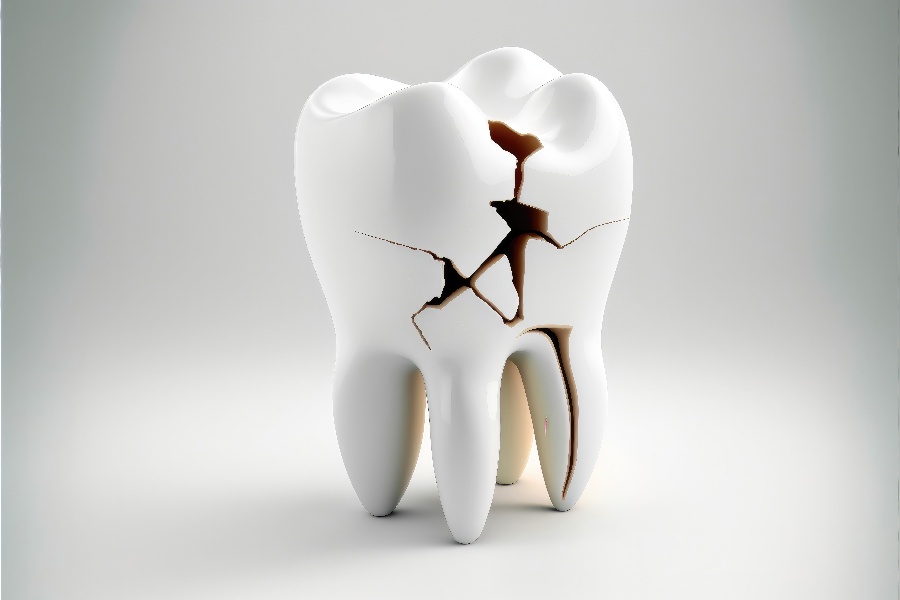Cracked teeth occur in about 80% of people over age forty. Many variables contribute to this high incidence, including the anatomy of your teeth and jaws, the force of your bite, and the foods you choose to eat. While some cracks are minor and require little or no treatment, others can result in tooth extraction and implant placement. The many symptoms caused by cracks in teeth have led to what dentists call Cracked Tooth Syndrome.
What Is Cracked Tooth Syndrome?
Cracked Tooth Syndrome (CTS) is a condition in which a tooth develops a crack or fracture. This defect can be shallow or deep and extend anywhere from the tooth's enamel to the pulp. It may or may not be visible to the naked eye.
Causes and Risk Factors for Cracked Tooth Syndrome
There are many causes and factors that can increase your risk of Cracked Tooth Syndrome. Understanding these can help you take steps to prevent extensive treatments or tooth loss. Some of the common causes and risk factors include the following:
- Teeth grinding or clenching (bruxism). Excessive teeth grinding or clenching can place significant pressure on your teeth, resulting in cracks and fractures.
- Trauma or injury to the tooth. Accidents or injuries to your mouth can fracture, crack, or chip teeth.
- Chewing on hard non-food objects. Chewing on ink pens or pencils and fingernails or using your teeth as tools can lead to cracks and fractures.
- Large fillings or other dental work. Teeth with large fillings or those that have undergone multiple dental procedures are more prone to cracking.
- Aging. Our teeth become more brittle and susceptible to cracks and fractures as we age.
- Poor oral hygiene. Poor oral hygiene can lead to tooth decay, which weakens the tooth and makes it more susceptible to cracking.
- Bite misalignment. An uneven bite can cause certain teeth to bear more pressure than others, leading to cracks and fractures.
- Dry mouth. Saliva plays a crucial role in keeping teeth hydrated and protected from damage. A dry mouth from medications, mouth breathing, or a medical condition can cause dry and brittle teeth that crack more easily.
- Eating hard or sticky foods. Hard or sticky foods such as ice, popcorn kernels, hard candy, or chewy candy can place excessive force on teeth and lead to cracks and fractures.
- Smoking. Smoking can weaken teeth and increase your risk of dental problems, such as cracks and fractures.
- Exposure to acidic foods and drinks. Regularly consuming acidic foods and drinks, such as citrus fruits, soda, and sports drinks, can weaken your enamel and make teeth more prone to cracks and fractures.
- Certain medical conditions. Certain medical conditions that affect tooth enamel, such as amelogenesis imperfecta, can increase your risk of Cracked Tooth Syndrome.
Symptoms of Cracked Tooth Syndrome
Cracked Tooth Syndrome can be a difficult condition to diagnose. The symptoms can be hardly noticeable initially. This leads patients to ignore the symptoms until the condition is worse. There are some common signs and symptoms, such as:
- Sensitivity to hot, cold, or sweet foods. Cracks can cause sensitivity to temperature and sweet foods since these can irritate nerve endings in the tooth.
- Pain when biting or chewing. Pressure on the tooth can cause pain or discomfort, particularly when biting or chewing.
- Pain that comes and goes. The pain associated with Cracked Tooth Syndrome may come and go, making it difficult to isolate the cracked tooth.
- Swelling or inflammation around the affected tooth. An extensively cracked tooth can cause an infected dental pulp, leading to red, swollen gums around your tooth.
- Visible crack or chip in the tooth. In some cases, the crack or chip in the tooth may be visible. A crack can become stained from foods and drinks if it remains long enough.
- Pain or discomfort when releasing bite pressure. You may experience pain when you release after biting down rather than when biting down.
- Headaches or jaw pain. A cracked tooth can lead to headaches or pain in your jaw or face.
How Is Cracked Tooth Syndrome Diagnosed?
Because of the difficulty of diagnosing Cracked Tooth Syndrome, dentists often must use various tests, techniques, and instruments to determine the cause of CTS symptoms. Since it is rare for one test to conclusively detect a cracked tooth, one or more of the following can be used to make the diagnosis:
- Comprehensive dental exam. A thorough dental exam is the first step in diagnosing Cracked Tooth Syndrome. The dentist will examine the affected tooth and surrounding teeth and take a detailed medical history.
- X-rays. X-rays can help detect cracks or fractures in the tooth that may not be visible to the naked eye. In some cases, the dentist may use a special dye that can highlight cracks in the tooth on the X-ray image.
- Transillumination. This technique involves shining a bright light through the tooth to detect any cracks or fractures.
- Bite test. The dentist may perform a bite test, in which the patient bites down on a special dental instrument to determine if the tooth is sensitive to pressure.
- Dental explorer. A dental explorer is a small, pointed instrument that can detect cracks or fractures in the tooth's surface.
- Cone beam computed tomography (CBCT). This type of 3D imaging can provide more detailed information about the structure of the tooth and surrounding tissues.
- Pulp vitality testing. Your dentist may test the health of one or more teeth to locate a cracked tooth. This is usually done using ice, biting, and possibly an electric pulp tester.
Treatment for Cracked Tooth Syndrome
Treatment for Cracked Tooth Syndrome depends on the severity and location of the crack. In some cases, no treatment may be necessary; in others, more extensive treatment may be required. Here are some common treatments for Cracked Tooth Syndrome:
- Dental bonding. Dental bonding may be an option if the crack is small and doesn't extend too far into the tooth. This involves applying a tooth-colored resin material to your tooth to fill in the crack, restore its appearance and function, and help prevent the crack from worsening.
- Dental crown. A dental crown may be necessary if the crack is more extensive or the tooth has undergone a root canal. The crown is a custom-made cap that covers the damaged tooth to provide protection and support.
- Root canal therapy. If the crack has reached the tooth's pulp, a root canal may be necessary to remove the damaged tissue and prevent infection.
- Extraction. Extraction may be necessary in severe cases where the crack has caused irreparable damage to the tooth.
- Observation. If the crack is very small and doesn't cause any symptoms, the dentist may simply monitor your tooth for any changes and provide recommendations for preventing further damage.
It's important to note that early detection and treatment of Cracked Tooth Syndrome can help prevent the need for more extensive and costly treatment in the future.
Schedule an Appointment
If you suspect that you may have a cracked tooth, contact Palmetto Dental Arts as soon as possible for an evaluation and appropriate treatment. Call us or contact us online.







